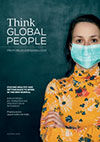Global Mobility Policies: Good Governance And Effective Communication
In these times of Covid-19, now is a good opportunity to review the relevance of your global mobility policies. Dr Sue Shortland explains how sound principles underpin good decision-making and effective communication.

Click on the cover to access the digital edition or read all of the articles on our website.
Global mobility trends after Covid-19
Recent survey research into global mobility policy trends – such as that conducted by Santa Fe, winner of the Relocate Global 2020 Award for excellence in research – highlights the latest trends across a range of assignment types.Even before Covid-19, Santa Fe’s 2019 research showed 70% of organisations used short-term assignments of under a year (averaging six months). A further 65% used international business trips under three months to service their international work demands. The long-term assignment (over a year’s duration) used for strategic as opposed to developmental purposes stands at 63%.This interesting research result indicates that flexpatriation (including commuter, rotation and extended business travel) appears to be overtaking more traditional expatriation, even before the current pandemic. The data also indicate that 47% of firms were using international commuting arrangements (of up to three years), suggesting the replacement of family-accompanied long-term mobility by solo-status flexible assignments.Is Covid-19 accelerating change in global mobility?
The current coronavirus crisis is likely to result in an acceleration of the trend to use virtual international mobility as a replacement for physical movement of individuals and their families to host locations, particularly given potential future lockdown scenarios. Once businesses, individuals and their families have become used to the new normal, the virtual environment may potentially be supplemented by business trips and/or shorter periods of international commuting. Of course, this assumes there are no restrictions on travel such as quarantine requirements on arrival/return in countries reporting low incidence of the disease.These approaches may further reduce the reliance on traditional long-term assignments. Rotational assignments in sectors where location challenges predicate the need for periods in-country followed by lengthy rest periods at home, such as in oil and gas exploration and remote mining operations, may mean short, but regular, host-country on-shift periods interspersed by home country return periods. These may become a more frequently used global mobility option in a range of other industries.Nevertheless, the strategic purpose of the assignment and the nature of the work being performed will dictate the options that can apply to global working and the assignment types used to service it. Physical presence is required in many industries where skills are required on the ground to complete tasks that cannot be done remotely. Global mobility professionals may need to consider whether servicing these roles can make use of flexpatriate working, thereby potentially reducing the need for family mobility. This can assist in managing duty of care if family members remain at home.
Physical presence is required in many industries where skills are required on the ground to complete tasks that cannot be done remotely. Global mobility professionals may need to consider whether servicing these roles can make use of flexpatriate working, thereby potentially reducing the need for family mobility. This can assist in managing duty of care if family members remain at home.Improving business flexibility and the employee experience
Looking ahead, research suggests the majority of organisations are increasingly focused on the twin strategic global mobility objectives of improving business flexibility and delivering a positive employee experience.Enhancing both will influence policy content and design decisions; the focus of control in policy implementation; and how the terms and conditions within assignment policies are communicated. These objectives apply to all types of assignments and the global mobility policies that underpin them. From a practical perspective, it is therefore critical to define what is meant by business flexibility and employee experience, especially as these are somewhat nebulous terms and refer to a multitude of understandings. For example, improved flexibility for the business may lie in, for example, enhanced technology, simplification of mobility policy delivery options, core-flex options and so on.For employee experience, improvements may refer to offering online-driven information, flexibility and choice of benefits, cash lump sums, cafeteria benefits, tailored programmes, focused delivery of items and so on. It is likely that the nature of the positive employee experience is as unique as each individual move. It is important therefore that global mobility professionals talk to the business, as well as assignees, to ensure a full understanding of how business flexibility and the mobility experience can be improved.Core-flex arrangements
A further current area of interest lies in the use of core-flex global mobility policies. According to AIRINC's 2020 research into this aspect of global mobility, only 14% of organisations currently use a core-flex approach to global mobility policy. Yet, 36% of firms are considering introducing core-flex in the future.The current Covid-19 crisis places increased emphasis on the potential benefits of using a core-flex arrangement to assist with business flexibility – something likely to become even more paramount during and after the pandemic. Core-flex arrangements can be used to address changing business needs, different types of mobility and deliver competitive practice while serving to reinforce the mobility culture of an organisation.It is important to note that core-flex arrangements differ from cafeteria benefits programmes. Under the latter, the emphasis lies in employee choice and the focus is on improving employee experience. However, employees can make poor choices and undermine policy intentions. Clear communication is needed to ensure where employee choice is included the implications of employee’s decisions are made clear and understood. In a core-flex policy, core elements are those policy elements that must be provided. Typically, these relate to compliance and duty of care. The flexible elements are designed to cover the range of likely employee needs. The relevance of core policy components is therefore critical to the business – particularly now and going forward.Any potential increase in flexpatriation brings to the fore the dangers of non-compliance with immigration, tax and social security rules. The health issues associated with a resurgence of Covid-19 highlights employers’ duty of care provision – especially in respect of emergency evacuation, health insurance and hospital access. In reviewing policy design and composition, global mobility professionals should consider carefully their duty of care and compliance coverage. Emphasis must also be placed on communicating to the business and assignees the importance of these elements.
In a core-flex policy, core elements are those policy elements that must be provided. Typically, these relate to compliance and duty of care. The flexible elements are designed to cover the range of likely employee needs. The relevance of core policy components is therefore critical to the business – particularly now and going forward.Any potential increase in flexpatriation brings to the fore the dangers of non-compliance with immigration, tax and social security rules. The health issues associated with a resurgence of Covid-19 highlights employers’ duty of care provision – especially in respect of emergency evacuation, health insurance and hospital access. In reviewing policy design and composition, global mobility professionals should consider carefully their duty of care and compliance coverage. Emphasis must also be placed on communicating to the business and assignees the importance of these elements.Designing core-flex programmes
There are a number of options when designing and introducing core-flex arrangements, as opposed to cafeteria benefits. At its simplest, a core-flex policy provides core benefits to all, ensuring compliance and duty of care are met regardless of assignment type and location. Each additional support element – the flex components – are either given or not with the decision-making under the control of the business. Core provision plus an incremental approach to any flex employee support provides a more tailored core-flex option and meets the business flexibility objective more closely. The core is again delivered to all, but a flexible approach is offered on delivery of support items from a series of pre-defined support levels (such as fixed amounts of time/money/items).A further, and even more tailored, approach again delivers the core items to all, but provides complete flexibility for the business to increase or decrease levels of support given from standards set for each relocation benefit. The level of benefits can be increased or decreased to match each assignment type, employee need and business requirement.In determining which option to adopt it is important to remember that appropriate technology will be needed to capture choices and ensure these are applied appropriately to the type of assignments undertaken.It is also important to remember that in the design of a core-flex arrangement, the emphasis should be on business flexibility rather than employee choice. Control over benefit provision should lie within the remit of the business.The role of global mobility professionals
Global mobility professionals should therefore advise the business that the use of core-flex arrangements can help them meet the needs of various assignment types, particularly when these are run in combination (as may well prove to be the case post-pandemic), but will work most effectively when:- employee needs are fully understood
- the programme can be supported by appropriate technology
- differential treatment of assignees/employee groups is considered acceptable within the company’s culture.
This article is taken from the first issue of Think Global People, the new home of Relocate Magazine.
Click on the cover to access the digital edition or read all of the articles on our website.
Follow the links for more talent management and international assignments news from Relocate Global
Subscribe to Relocate Extra, our monthly newsletter, to get all the latest international assignments and global mobility news.Relocate’s new Global Mobility Toolkit provides free information, practical advice and support for HR, global mobility managers and global teams operating overseas.
 Access hundreds of global services and suppliers in our Online Directory
Access hundreds of global services and suppliers in our Online Directory
©2025 Re:locate magazine, published by Profile Locations, Spray Hill, Hastings Road, Lamberhurst, Kent TN3 8JB. All rights reserved. This publication (or any part thereof) may not be reproduced in any form without the prior written permission of Profile Locations. Profile Locations accepts no liability for the accuracy of the contents or any opinions expressed herein.







































